
Leather Furniture Care 101: How to Protect and Clean Quality Leather Sofas
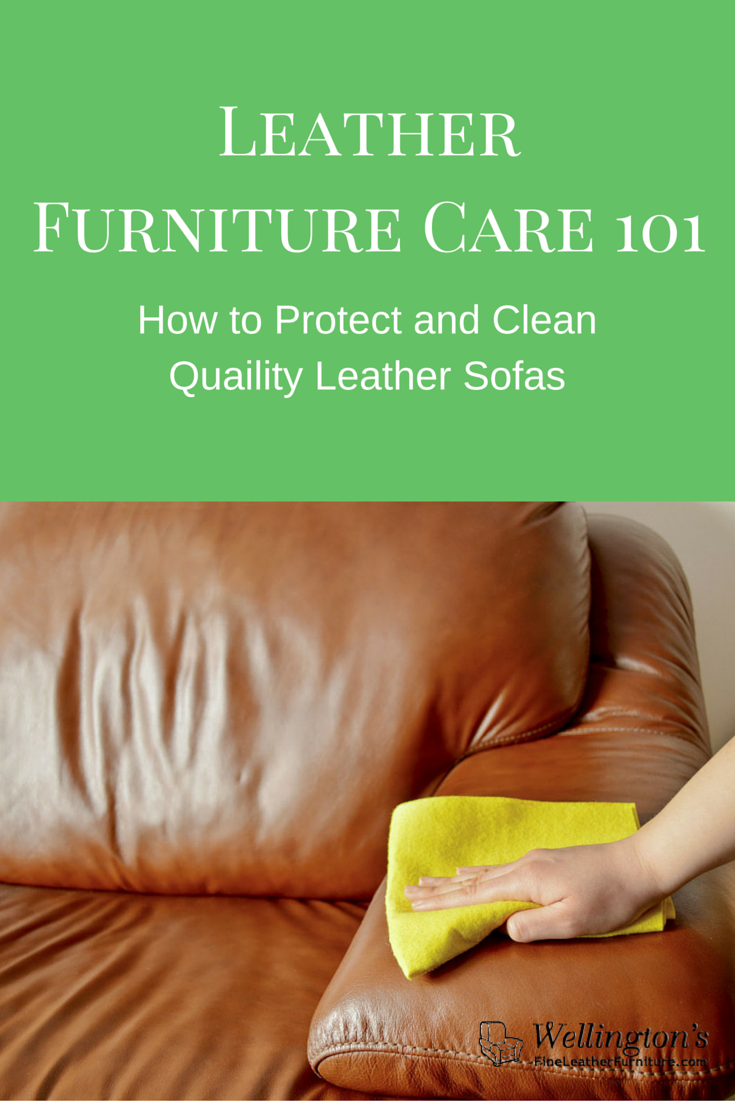
Adding a quality leather sofa or set to your living room?
High quality leather furniture is an excellent investment. It’s looks great and will last a long time.
That makes it the kind of asset you want to protect.
Here, we’ll show you how to do just that. We’ll also inform you about the things you’ll need to add to your weekly, monthly, and yearly housekeeping list.
Don’t worry, it’s not too much. But we are going to dive deep so that leather newbies and aficionados alike can get something out of it. The goal is to give you everything you need to know in order to make your leather furniture last as long as possible.
Most first time high quality leather furniture buyers are in one of two camps when it comes to leather furniture care:

Second, the pessimists. If you’ve stayed away from leather furniture in the past because you’ve heard negative comments, we feel for you. We’d ask that you give us a chance to show one thing...
Leather furniture maintenance isn’t hard.
Your only real focus will be on the leather upholstery itself. And when you factor in the benefits, it’s more than worth it.
Leather is not just a great investment. It is one of the few things in this life that gets better with age. That is only if is taken care of.
This is something you should probably consider before you buy.
Protection from Hazards
High quality leather lasts for decades. It’s hard to puncture and even harder to tear or rip.
However, there are a few things that can do serious damage to the leather on your couch or sofa.
Sunlight
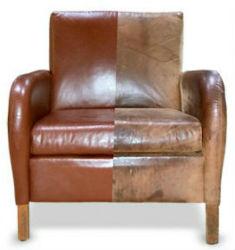
First, its UV rays damage color. This can be especially bad on unfinished leathers as well as darker leathers.
Second, it can cause drying. When leather gets too dry, it cracks—much like your skin does. Too much sunlight (or heat in general) will slowly rob the leather of its natural oils over time.
There are products that can help protect your leather furniture from the sun, but our advice is to just keep it out of the sunlight as much as possible.
If you can’t, go with a finished (aka protected or pigmented) leather in a lighter color and make sure to keep it well conditioned (more on that later).
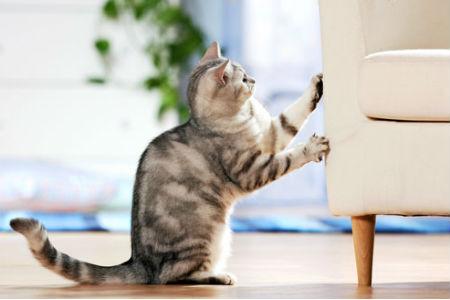
Pets are any piece of upholstered furniture’s worst enemy.
Truth be told, leather will stand up to your pets better than most upholstery materials. Remember, it can stand up to a tremendous amount of abuse.
The issue though, is aesthetics.
Many people love authentic leather for its natural markings, what we call the “grain”. However, those natural markings do not generally include years of dog slobber and cat scratches.
Of course, this is a personal choice.
Especially with dogs, many owners of protected-finish sofas and armchairs don’t mind.
Oils and Liquids
Perhaps the biggest hazard to your new quality leather furniture set is you.
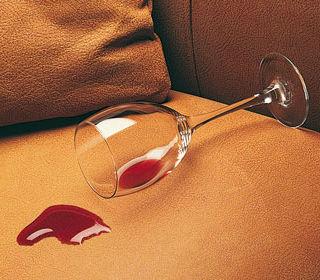
That includes beverages, sauces, oil, grease, even water itself. Depending on the type of leather on your furniture, you might need to ban food and drinks on or near it.
No matter what kind of finish your leather has, make sure you wipe up spills immediately. Do not give them time to set.
Stick to a dry cloth if possible. If you must, use as little water as will get the job done. The more water you use, the larger the area you’ll end up needing to clean. Do not soak in water or any other non-specialized solution.
Finished vs. Unfinished
If you’re thinking of buying a new piece of leather furniture and all the talk of protected, aniline, pigmented, and natural leathers in the previous sections confused you:
Take a look at The Definitive Guide to Buying Leather Furniture and you’ll learn everything you need to know about the different types of leather that are available. Plus, it contains all the other need-to-know-info before making such a big decision.
Once you have your furniture, this part is done. You’ll have to make sure your lifestyle fits your investment, otherwise it will inevitably lose its value.
And if you really want it to keep its value, you’ll need to do a bit of work to keep it in the best of conditions.
Routine Maintenance
Truth be told, it’s not hard to take care of the leather on your furniture.
For the most part, it’s the same as any other large item in your home. You might say there are a few weekly, monthly, and yearly chores you’ll need to incorporate into your new housekeeping routine.
Fortunately, though, nothing will take you that much time or effort and it will all be worth it in years to come.
Regular Debris Removal

But on a weekly basis, there really isn’t much extra work you’ll need to do:
You want to remove any debris on seat cushions, under seat cushions, along the back, or on the arms. It’s a simple matter of not allowing crumbs, fuzz, dirt, and general grime to be rubbed into the leather as people use the couch.
Most people can just add the couch to their usual vacuuming and dusting routine.
Use a white, cotton, slightly dry cloth to wipe all the surfaces of the couch down. This way you can see the dust you pick up and trust that the leather won’t be damaged. For vacuuming, make sure to use the brush attachment instead of the hose by itself.
Condition and Protect
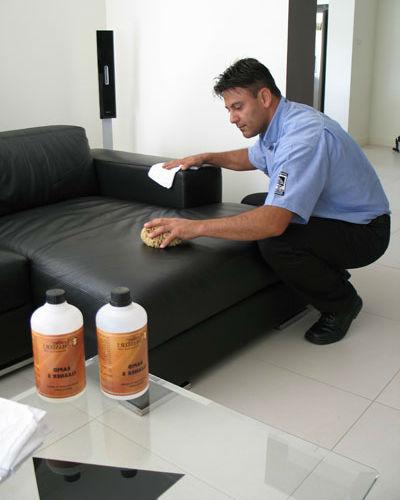
However, new owners shouldn’t see this as a drawback. Leather is made from animal hide. So, to retain all of its most desirable properties, it needs to be taken care of.
Just like your skin, it needs to be moisturized and protected.
When leather leaves the factory, it typically has about a 25% moisture content. Over time, that moisture evaporates away. Leather conditioners are used to replenish it.
When you first bring leather furniture home, you shouldn’t need to worry about it. From there, if you live in a dry climate, leather conditioners are recommended as needed.
What you should use to condition your furniture comes down too many factors. We highly recommend calling your sales consultant for their recommendation.
While you’re at it, find out if they recommend any protective products. There are various products on the market made to protect color or repel spills. Depending on the type of leather, these may serve to extend the leather’s life or protect its appearance.
Follow all instructions that come with conditioners and protectants for the best results. Also, it’s important to take care of the entire surface of your furniture’s upholstery.
Additionally, well taken care of leather is easier to clean.
Deep Cleaning
When it comes to cleaning leather, the number one thing you should do is prevent it from being necessary.
When you can’t, be as cautious as possible during the cleanup process:
Start with the least abrasive solutions first.
If a dry towel works, stop there. If a moist towel works, stop there. If you need something more, consult the store to find out what that should be.
The first rule of thumb is to never use detergents or any products containing solvents or oils. Still, there are plenty of safe and effective leather cleaners on the market.
If you need one, be sure to read all the instructions. There are also a few general rules to follow when cleaning leather with a solution.
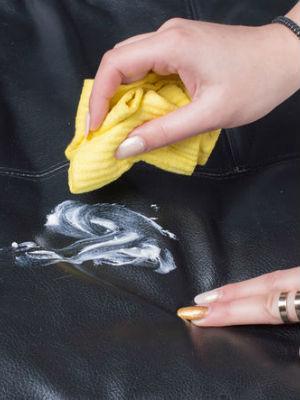
Second, stick to cotton, terry cloth.
Third, scrub in all directions to dislodge dirt within the grain and along the seams.
Fourth, clean a square foot or less then wipe it completely clean.
Fifth, condition and protect soon after any cleaning with a solution.
If you have an extremely dirty or damaged piece of leather furniture that you are intent on salvaging, you’ll need to see a professional.
Final Thoughts
Now you should have a strong understanding of how to properly care for your leather furniture: from protecting, to conditioning, to cleaning.
The advice in this post will help ensure that your newest piece is a solid long-term investment. That’s because the only way to get the full value from your leather furniture is to take good care of it.
So, use this information well. And if you’ve found it valuable, please like and share this content on your favorite social media platform so that more people can get the same high-quality leather care education.
Have any more questions? Contact us and we can help.








